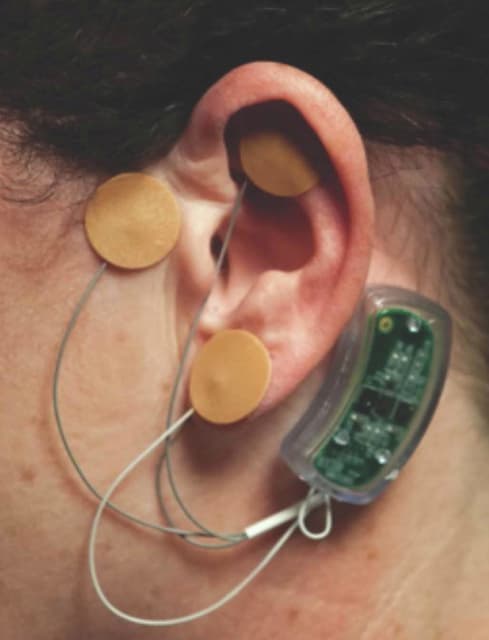
RICHMOND, Ind. – As the reality of the heroin crisis sinks in, community members and organizations are coming together to fight the epidemic from every possible angle – educational, legal, mental, emotional, spiritual and medical.
As part of ongoing efforts to address the heroin epidemic, Reid Health and the Heroin is Here committee are exploring ways to bring new tools for addiction treatment to the area. Among these is a new device designed to help with withdrawal from opiates.
The device, called the Neuro-Stim Systems (NSS) BRIDGE, was developed by Indiana company Innovative Health Solutions and offers an alternative to the pain of opioid withdrawal in patients overcoming the disease of addiction. The BRIDGE is a tool that could help with one of the most challenging aspects of overcoming an opioid addiction – the initial detox, company officials said.
In addition to providing benefits to detox patients through non-narcotic pain relief, it also could prove to be a more cost-effective way to treat addiction.
Indiana legislators, Reid Health leadership and physicians, Wayne County law enforcement, prosecutors and representatives from the community attended a presentation about the BRIDGE in Reid Health’s Lingle Hall recently to learn more.
“This is a tool to help with the withdrawal and detox portions of the disease,” said Brian Carrico, vice president of Innovative Health Solutions. “This is a paradigm shift in the treatment of addiction through innovative technology.”
Addiction withdrawal, especially opioid and heroin detox, is painful and typically takes 10 to 14 days for a person to overcome.
“Imagine the worst flu you’ve ever had. Now imagine it 10 times worse,” said Dr. Eric Davis, co-executive director of the Life Recovery Center, a facility for the treatment of substance abuse based in Indianapolis. “People come to me and say that their family member is going through withdrawal. They ask if he’s going to die. I tell them, ‘He’s probably not going to die, but he’s going to want to.”
Many patients quit during this challenging detox time, even before long-term treatment – such as Naltrexone or Vivitrol – can begin.
The BRIDGE is a pain relief device that can reduce pain by up to 75 percent within 30 minutes, and it can reduce detox from 10 to 14 days down to just two to four days. Using BRIDGE helps more patients make it to long-term treatment.
Studies are showing the BRIDGE helps eight out of 10 patients successfully progress to a long-term treatment in fewer than four days.
The BRIDGE is intended to be one part of a system of treatment that includes detox, therapy and long-term treatment.
Craig Kinyon, president/CEO of Reid Health, said his team welcomes anything that brings new hope to better manage withdrawal and addiction.
“Our health system recognizes the impact of heroin and opiate addiction on our communities,” he said. “We have to attack this problem with all tools at our disposal. This new technology provides great promise for managing withdrawal. We also recognize that technology alone won’t be effective without addiction counseling. In other words, we need to continually treat the ongoing disease of addiction.”
The device, which costs about $495 per patient, is followed by treatment with a medication like Vivitrol, along with therapy over the course of 16 months. The entire course of treatment costs about $15,000, and it is offset by some insurance plans.
Indiana State Sen. Jim Merritt, R-31st District, attended the presentation and commented on the potential this technology has to not only save lives, but to decrease treatment costs and reduce the number of addicted individuals.
Many people struggling with opioid addiction end up in trouble with the law and end up in jail or prison. According to Merritt, it costs more than $44,000 to house a person in a correctional institution for a year, whereas a comprehensive treatment plan with the BRIDGE, Vivitrol and therapy would cost a comparatively inexpensive $16,000.
“We have a very good opportunity to rehab an individual,” Marrit said. “We need to make sure this is recognized as a disease and not a character flaw. We need to offer hope and empathy. But when you get down to it, in terms of dollars and cents, it’s crazy.”
Indiana State Rep. Cindy Ziemke, R-District 55, who also attended the presentation, spoke in favor of having the device as a componenet of an addiction treatment plan, hopefully supported by Medicaid and insurance.
“If we can get the correct funding, we would have a really comprehensive plan, and you would have no bigger fan than me,” Ziemke said.
For Ziemke, the battle is personal, as she herself found her son in the midst of a heroin overdose and has gone through years of the rehab struggle with him.
Percutaneous electrical nerve stimulation was originally used as a nonpharmacologic pain management technique as an alternative to more invasive methods.
Studies showed a moderate decrease in pain that was accompanied, unexpectedly, by a decrease in opioid use and dependence.
Researchers followed up on this discovery and began to use the method to help wean or reduce the dose of opioid medication in chronic pain patients.





